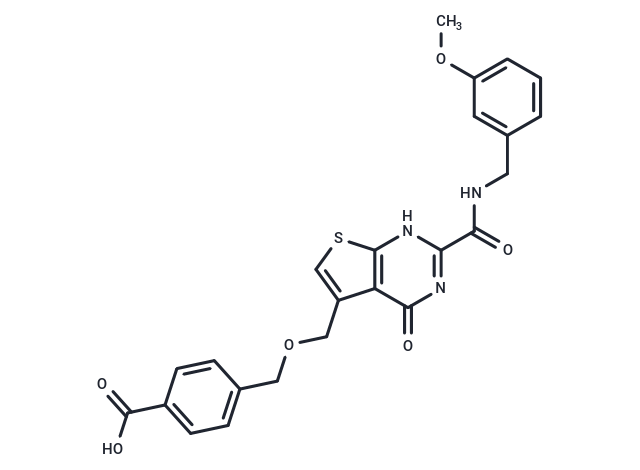Shopping Cart
Remove All Your shopping cart is currently empty
Your shopping cart is currently empty
T-26c is a highly potent and selective matrix metalloproteinase-13 (MMP-13) inhibitor with an IC50 of 6.75 pM.

| Pack Size | Price | USA Warehouse | Global Warehouse | Quantity |
|---|---|---|---|---|
| 1 mg | $41 | In Stock | In Stock | |
| 2 mg | $58 | In Stock | In Stock | |
| 5 mg | $97 | In Stock | In Stock | |
| 10 mg | $155 | In Stock | In Stock | |
| 25 mg | $263 | In Stock | In Stock | |
| 50 mg | $447 | In Stock | In Stock | |
| 100 mg | $646 | In Stock | In Stock | |
| 1 mL x 10 mM (in DMSO) | $98 | In Stock | In Stock |
| Description | T-26c is a highly potent and selective matrix metalloproteinase-13 (MMP-13) inhibitor with an IC50 of 6.75 pM. |
| Targets&IC50 | MMP13:6.75 pM (cell free) |
| In vitro | T-26c was the highly potent and selective MMP13 inhibitor with an IC50 value of 6.9 pM and more than 2600-fold selectivity over the other related metalloenzymes. Furthermore, the inhibitor was shown to be active in bovine nasal cartilage explants assay. T-26c significantly inhibited the breakdown of collagen (87.4% inhibition at 0.1 μM) in IL-1b and oncostatin M stimulated cartilage. |
| In vivo | Oral administration of the disodium salt formulations of T-26c to guinea pigs resulted in significant increases in AUC (8357 ng·h/mL) and Cmax (1445 ng/mL) compared with those of the free acid T-26c (AUC = 6478 ng·h/mL and Cmax = 911 ng/mL). The compound was well absorbed in all species at the oral dose of 10–20 mg/kg. |
| Kinase Assay | The MMP assay buffer consisted of 50 mM Tris–HCl (pH 7.5), 10 mM CaCl2, 150 mM NaCl, and 0.05% Brij-35. The pro-MMPs were activated by preincubation with 1 mM aminophenylmercuric acetate (APMA) in assay buffer at 37 °C for 2 h (MMP-1, 2, 7, 8, 10, and 13) or 18 h (MMP-3 and 9). The TACE assay buffer consisted of 25 mM Tris–HCl (pH 9.0), 2.5 mM ZnCl2, and 0.005% Brij-35. The pro-MMPs were activated by preincubation with 1 mM aminophenylmercuric acetate (APMA) in assay buffer at 37 °C for 2 h (MMP-1, 2, 7, 8, 10, and 13) or 18 h (MMP-3 and 9). Enzyme inhibition assays were performed in an assay buffer containing enzymes and fluorescence peptide (Cy3-PLGLK(Cy5Q)AR-NH2 for MMPs, Cy3-PLAQAV(Cy5QL-2,3-diaminopropionic acid)-RSSSR-NH2 for TACE) in the presence of the various concentrations of inhibitors. Following incubation at 37 °C for 40 min, the reaction was terminated by addition of EDTA (pH 8.0). The increase in fluorescence as measured by Farcyte spectrofluorimeter. Enzyme activity (%) was determined as following equation: Enzyme activity (%) = (X - C)/(T - C) × 100, where X = the fluorescence count with inhibitor, T = the fluorescence count without inhibitor and C = the fluorescence count with EDTA. IC50 values of inhibitors were obtained with iterative fitting package. |
| Cell Research | Bovine nasal septum cartilage was sliced, and the slices were maintained in the medium of a 1:1 (v/v) mixture of Dulbecco's modified Eagle's MEM and Ham's F-12 medium (DMEM/F-12) containing 10 % fetal calf serum overnight. After confirming that the slices were not contaminated, they were cultured in DMEM/F-12 medium containing 20 μg/mL gentamycin, 50 μg/mL streptomycin, and 50 U/mL penicillin (culture medium) for 2 days at 37 °C. The cartilage slices were cut into small cubes (ca. 1mm3) and transferred individually into wells of a 96 well plate with 100 μL of culture medium. For the collagen degradation assay, the medium was supplemented with 10 ng/mL IL-1β and 50 ng/mL oncostatin M in the presence or absence of compounds. The cartilage was incubated for 2 weeks. The supernatants were harvested and replaced with fresh medium containing identical test compounds every 7 days. Supernatants of day 7 and day 14 were collected and stored at -20 °C until assay. At the end of the culture, the remaining cartilage was completely digested with papain. Hydroxyproline release in the media from each explant was determined as a measure of collagen degradation by use of chloramine T and p-dimethylaminobenzaldehyde. The percentage of inhibitory activity against collagen degradation was calculated as follows: % of inhibition = [(% of collagen degradation with IL-1b and OSM) - (% of collagen degradation with IL-1β, OSM, and test sample)]/[(% of collagen degradation with IL-1β and OSM) - (% of collagen degradation without additives)] × 100. |
| Molecular Weight | 479.51 |
| Formula | C24H21N3O6S |
| Cas No. | 869296-13-9 |
| Smiles | COc1cccc(CNC(=O)c2nc(=O)c3c(COCc4ccc(cc4)C(O)=O)csc3[nH]2)c1 |
| Relative Density. | no data available |
| Storage | Powder: -20°C for 3 years | In solvent: -80°C for 1 year | Shipping with blue ice/Shipping at ambient temperature. | |||||||||||||||||||||||||
| Solubility Information | DMSO: 12 mg/mL (25.03 mM), Sonication is recommended. H2O: Insoluble | |||||||||||||||||||||||||
| In Vivo Formulation | 10% DMSO+40% PEG300+5% Tween 80+45% Saline: 1 mg/mL (2.09 mM), Sonication is recommended. Please add the solvents sequentially, clarifying the solution as much as possible before adding the next one. Dissolve by heating and/or sonication if necessary. Working solution is recommended to be prepared and used immediately. The formulation provided above is for reference purposes only. In vivo formulations may vary and should be modified based on specific experimental conditions. | |||||||||||||||||||||||||
Solution Preparation Table | ||||||||||||||||||||||||||
DMSO
| ||||||||||||||||||||||||||
| Size | Quantity | Unit Price | Amount | Operation |
|---|

Copyright © 2015-2025 TargetMol Chemicals Inc. All Rights Reserved.